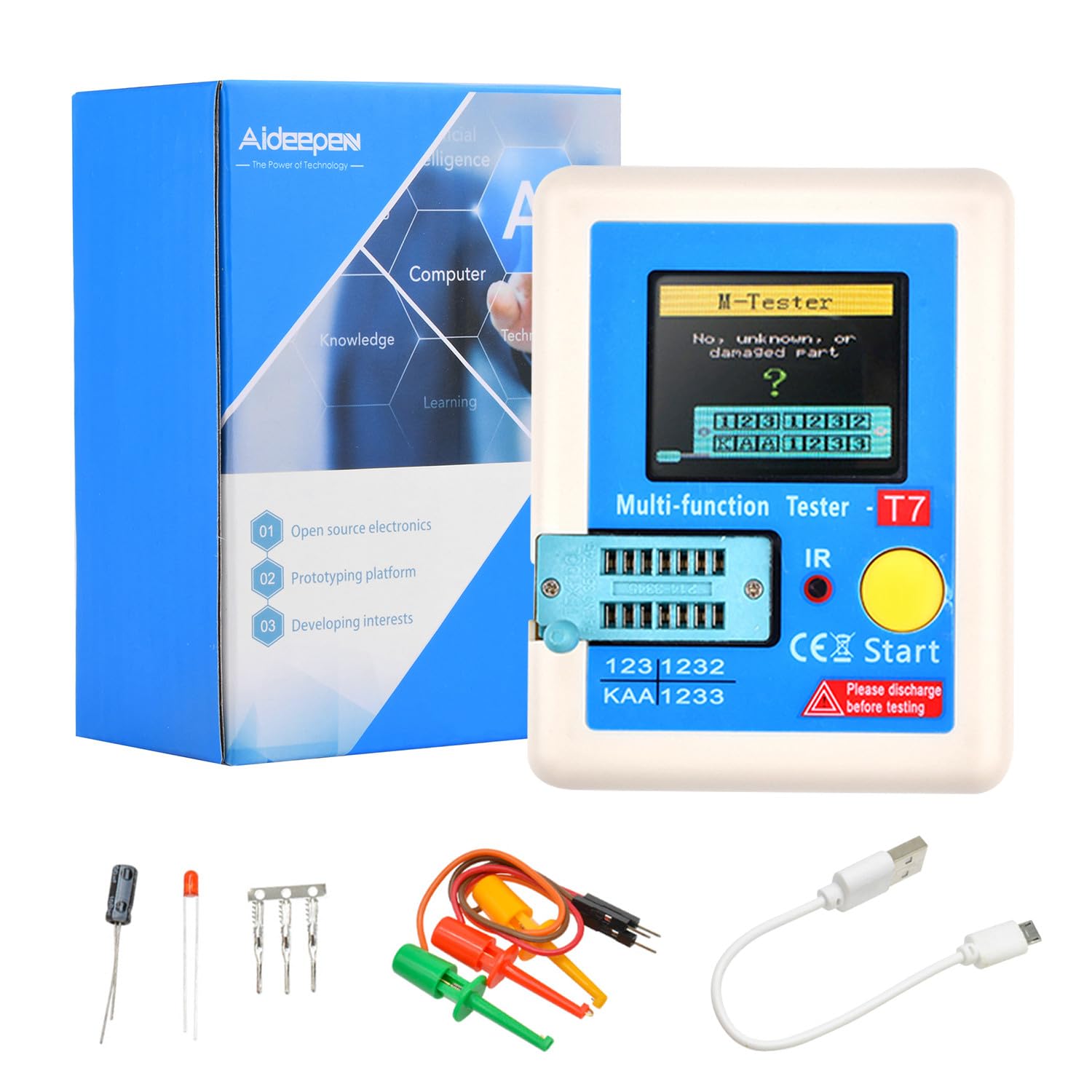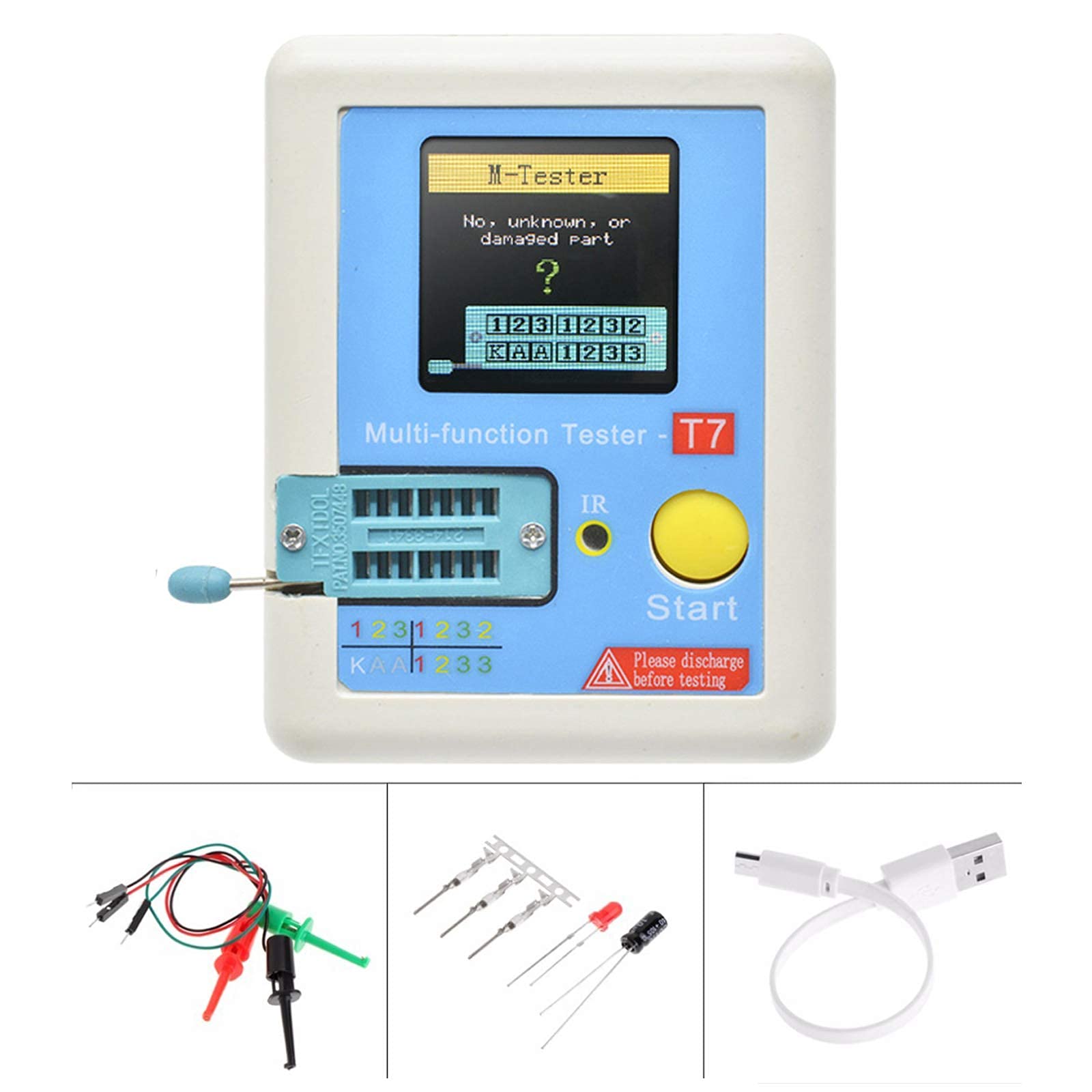









🔧 Unleash Your Inner Engineer with the LCR-T7!
The LCR-T7 Transistor Tester by Aideepen is a versatile, multi-functional device designed for professionals and hobbyists alike. Featuring a 1.8" TFT color display, it can automatically detect various electronic components, including transistors, diodes, and capacitors. With a built-in lithium battery and an auto shut-off function, this tester is both convenient and efficient, making it an essential tool for any electronics project.
J**M
Nice component tester
Works very well, helped identify failed components and made a repair job easy.
F**8
Nice, low cost passive component tester.
I purchased this product to test components easily and quickly. It can even prove what a mystery component is. For example, inductors look very similar to resistors in terms of shape, size and color bands. It is easy to confuse the two looking at them, at least for me 🙂. But in a circuit they behave quite differently. This tester will tell you right away if it is a resistor or an inductor and give you a sense if it is in specification. This is beneficial when testing a component from a circuit and you have no schematic. You will know what the component is following analysis and if it is good or not provided it is not shorted or open.The pros and cons:Pros: Nice crisp/bright TFT display and graphics, a little small for my old eyes but impressive for a product at this low cost. Built in rechargeable battery. It only costs pennies to keep the battery charged. This is probably cheaper than the cost of one 9 volt battery (that many other competing products run on) over the lifetime of this product. Included little jumpers with clips to connect component leads to the analyzer. Not the best quality and short for my liking but they work. Nice robust built in mechanism to lock the component leads in place to the analyzer. This secure lock down of the component leads helps to assure a sure and stable electrical connections. The analyzer can read the infrared pulses of the common infrared remote controls so prevalent in our lives. While I have not tried this function, I’m guessing that this can be used to troubleshoot a questionable remote. Is it dead and should be pitched or were the batteries bad?Cons: I don’t classify this analyzer as being “high precision” as the manufacturer claims. It will give you an idea of what is going on inside the component. If you want high precision I suspect that you would start with this analyzer to weed out bad components and then compare this with testing results with a more sophisticated device. To the hobbyist, this might not be practical. But for the price of this device it is wonderful to have this ability. As the old saying goes… something is better than nothing, just don’t put your whole blind trust in it. Use your instincts if something does not look and feel quite right.
J**N
Good enough for a hobbyist and worth the price
If you build electronics professionally you already know you don't need this tool. If you tinker around and make small projects or perform repairs, this little device is very much worth it.The build quality is fine, it's not robust by any means, but it doesn't feel like you got it from a gumball machine either. The directions are Google translated but using it is pretty self explanatory. It has slots to insert standard sized components and some pretty cheap but standard remote probes for bigger parts.I am actually surprised how accurate it is. I have tried NPNs, PNPs, mosfets, capacitors, diodes, resistors, and a few zener diodes of known values. Out of everything I only had one reading that was "incorrect enough" to cause a problem if I had been looking to ID and replace the component. That failure was a mosfet and the device returned "diode" about half the time and "resistor" the other times. The values it provided were actually close to some of the properties of the part, it seems something about that specific part number didn't "map" or identify like the other mosfets I tried. I did test several different ones of the same specs, all otherwise known to be working, and the same problem occured. Aside from that one specific mosfet, it's accurate enough that I have been able to replace components based off of the information it provides. I use the device for identification of older 1980s components that need to be replaced with equivalent ones, and it has worked fine.Tldr; not professional grade (obviously), but useful and worth the money to a casual electronics hobbyist.
S**E
Where has this thing been all of my life?
I had assumed in order to test components I would need an entire bench full of test equipment. One for Capacitors, another for Transistors, etc. To be able to test a 50-cent component, would I need to purchase $5K of equipment? Then I saw this Tester used in a YouTube video. When assembling electrical circuits on a breadboard, it is like cheating. :-DREALLY happy with it. I wish I had found it years ago!There are a bunch of these Testers on Amazon. They started as kits, then some mfgs decided to build an enclosure to house the components for a more professional look.They seem to have 2 basic designs, this one and the other "thinner" DROK unit. I purchased the DROK unit first, since it looked more compact. However, I quickly learned it has some serious issues. Obviously the ZIF (the aqua rectangle with the lever) was an afterthought. It fits in the socket, but the usual bumps on the underside of the ZIF (used to keep it above the PC board so solder can flow under it) keep it from seating properly. When moving the lever to clamp onto the leads of the component to be tested, the entire ZIF tips to the left. Unless you hold the ZIF in-place, the lever will unseat the pins on the right-side as it tilts to the left. Feels really wiggly, and very unprofessional. It could be glued in-place, but that seems like a ghetto work-around. The other option is to NOT use the ZIF and just put the leads directly into the socket. This would work, but it required forcing all leads into the socket holes simultaneously. For 2-lead components, this is fine, but for transistors or others with 3+ leads, this is much more time consuming. The ZIF allows the leads to be inserted "loose", and the lever does the clamping. Much more convenient! And that is why they added the ZIF to this Tester, (even though it is an afterthought). That was the deal-breaker for me. The DROK unit was returned.The Aideepen unit is solid. The ZIF is fully incorporated and much easier to use. I also like the way the data is displayed better. On the left is the display from the DROK Tester. On the right is the Tester from Aideepen:DISPLAY(Please refer to the image.)Both Testers are testing the same component, which is a simple transistor.The part I do NOT like about the DROK display is the pins are labeled as "123=EBC", which means I have to translate the pins to the EBC (Emitter, Base, Collector) pins of the transistor.A better way to display this information is to place the EBC next to the pins (1, 2 & 3) in the diagram. This is shown in the screen shot on the right. Much less mental gyration required to correlate the pins to the EBC of the transistor.BATTERYThe DROK unit uses a 9-volt battery for power, not included. It displays the voltage of the battery on the screen. In fact it takes up the bottom 20% of the display, which is a bit of a waste. I would rather see more room for info about the component being tested than the onboard battery.Speaking of batteries, it eats batteries. I ran maybe 10 tests of different components. The battery started at 9.3v, and was drained to 9.0v. If a typical session requires the testing of 20 components, I would need to keep a spare battery around, or purchase pricey rechargeable 9v batteries. Conversely, the Aideepen Tester has a rechargeable battery on-board.There are 3 version of this Tester. I can't see a whole lot of difference. I assumed the most expensive one would have the latest firmware and be the most bug-free. (It might well be that the less expensive ones will work just as well, but it wasn't worth the saving to find out it doesn't after the 30-day return window closes. They are reasonably close to $30. Frankly, I would expect a Tester this sophisticated to be closer to $100. They are a bargain.One thing I wish it did was to test SMD components. If some extra pads were added, or an simple PCB were etched with some legs to insert into the ZIF, then it could.It is a bit of an Easter Egg Hunt to fine-tune it based on what I think the ratings should be. Does the component work properly, or is my circuit not working because the factory sent me a bad component?Being able to KNOW the component is "good" helps give me the confidence to troubleshoot my circuits.HIGHLY RECOMMENDED!
F**N
Pratique
J'aime beaucoup..Le seul point négatif..la batterie ne dure pas très longtemps
M**C
Livre la marchandise
Vraiment rapide pour trier des composantes en vrac. Permet de se concentrer sur le circuit au lieu du code de couleur/chiffres des conposante.
J**.
Handy little unit
Seems to be quite accurate when testing known capacitors and is excellent at identifying discrete semiconductors, resistors.
T**D
it actually works !
...delivered faster than by "slow boat".....works well for general testing of electronic components. I am very impressed with how it simply figures out which lead is which, and then shows a mini-schematic on the display. I bought 2 of these, and they agree reasonably well with each other when measuring the same component. I will likely get a couple more as Christmass gifts for my friends in electronics.
D**E
testeur
Rempli très bien son rôle. Facile à utiliser.
Trustpilot
1 month ago
3 days ago